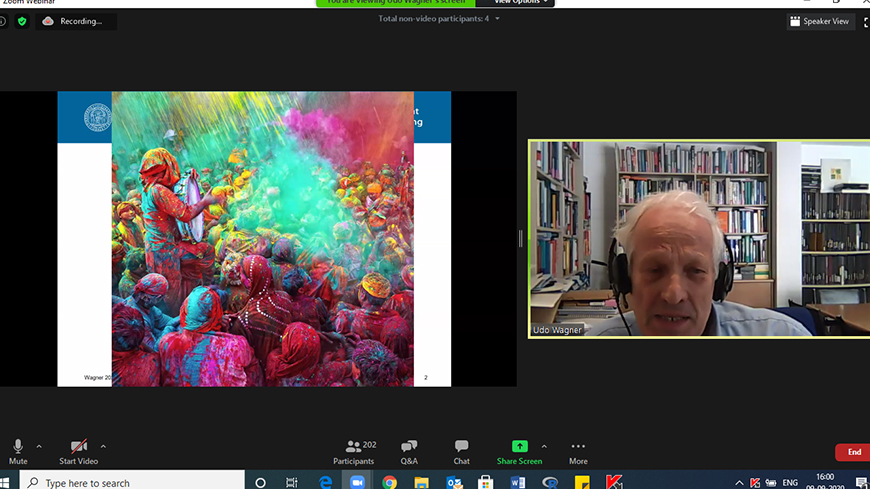
GL – Dr. Udo Wagner
Guest Session at Indus Business Academy, Bangalore
on
Sensory Marketing
Speaker: Dr. Udo Wagner, Professor – University of Vienna
Date: 9 Sept. 2020
Sensory marketing is a type of marketing that engages the consumers’ senses and affects their perception, judgment and behaviour (Aradhna Krishna, University of Michigan, USA). The topic explored the multisensory experience of products, services and brands as well as the important role the five senses (touch, smell, taste, hear and vision) play in determining a perception about anything and everything. Although Sensory marketing was formally acknowledged only in the 2000s, its roots date back to more than 100 years.
Dr Wagner talked about the conceptual framework of how senses lead to consumer behaviour given by Dr Aradhna Krishna, making students understand how sensation plays role in creating a memory, attitude or behaviour. He also provided an example of how human perception may differ from the initial sensation through the use of vision sense only.
He defined sensory marketing as not only a part of consumer behaviour, but a bridge between consumer behaviour and consumer science, where our senses are engaged to change or generate a perception, judgement, or behaviour.
Dr Wagner also explained the physiology of the human brain getting affected by sensory marketing. The Cerebrum is responsible for cognitive processing, Brain stem helps in processing/distributing the sensory information, and Cerebellum responds to it through coordinated body movements.
Psychophysics
It is a branch of psychology that quantitatively investigates the relationship between physical stimuli and the sensations and perceptions they produce.
With the use of Psychometric function (Atkinson et al., 1993), Dr Wagner discussed how the magnitude of stimulus is related to the percentage of positive response in the form of a sigmoid curve. One has to provide a stimulus above the magnitude of threshold stimulus to elicit a positive response but too much stimulus for a prolonged time would not increase the response. After a point response becomes constant. With the help of Weber’s Constant (Atkinson et al., 1993), students were able to understand that the magnitude of threshold differs from one sense to another.
Impact of stimulus on the brain could be understood by Neuro-marketing. Neuro-marketing uses brain-scanning technology (e.g. MRIs), to observe how people’s brains respond to a specific ad, packaging design, product design, etc. Marketers take these results and use them to create marketing strategies that consumers will find more appealing or motivating.
Sensory system
The five senses of the human body constitute the sensory system – the sense of touch, hear, smell, vision and taste.
- Smell
We can smell many things but name only a few. The smell, can evoke a lot of emotions, and even threat detection. It is hyperactive in case of trained dogs (e.g. German shepherd). Humans heavily use smell to relate to colours and memories.
- Sound
Sound travels through the external ear to the inner ear in the form of acoustic waves after being amplified in the middle ear. These waves are then transmitted, to the brain in the form of a nerve impulse. Here also, we have threshold frequency, sounds below 20 Hz or above 20,000 Hz cannot be heard by humans.
- Feel
The texture of the product is one of the key determinants, especially in the case of foods. In the case of clothes also, we try to determine the quality based on texture only. The Endowment Effect is the finding that people are more likely to retain an object they own than acquire it when they do not own it, and the texture of a product is the key determinant in this.
- Taste
In general, the taste is classified into 5 categories being sweet, sour, salty, bitter and umami. But flavours are different, which is a multisensory integration of all senses. Perception of food includes gustatory, oral-somatosensory and retro-nasal olfactory signals (Small, 2012).
- Vision
We relate colour to a lot of things. E.g. Ikea uses blue and yellow colour, which is similar to the flag of Sweden; its country of origin. Similarly, Tata Tea Premium uses white, orange and green, similar to the Indian flag.
Conceptual models
Dr Wagner provided seven conceptual models explaining the relation between Stimulus and Response. Our senses aid in the process — from stimulus to the response. Dr Wagner also talked about modal, amodal and crossmodal in these conceptual models. Students learnt about cognitive stimulus also. Although, its impact is weaker than the sensory stimulus.
Conclusion and Q & A
Dr Wagner was generous enough to answer the queries at the end of the session. Faculty members, as well as students, actively took this opportunity to ask their queries. One such question was, “How much region-specific is sensory marketing?” Dr Wagner clarified that the manner of shopping is the key determinant here. It changes from social norms like touching, which is very common while buying. Another question was, “How could we use sensory marketing in the current digital era?” Dr Wagner elucidated that one can elicit sensory experience with the use of cognitive stimuli.
Dr Wagner gave his important time and threw light on the emerging topic of Sensory Marketing. He explained it as Multisensory Integration that impacts consumer behaviour, attitude and perception. He explained the topic in a simplified manner, for better understanding and used research papers, to provide up-to-date knowledge. Through his examples, students understood the concept more precisely and related to its application in the market.
Dr Udo Wagner encouraged students to explore sensory marketing and also highlighted that there is a lot, which is still to be determined regarding the application of sensory marketing in various fields.
Prof Narendra Babu, Asst. Professor – Marketing, IBA Bangalore, gave the vote of thanks to Dr Udo Wagner, for such an insightful session on the behalf of faculty members and students.
Tag:Guest Lecture, udo wagner
